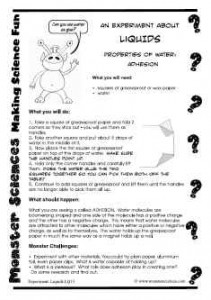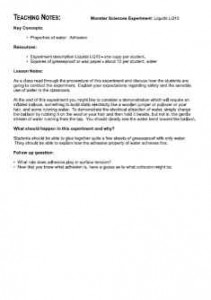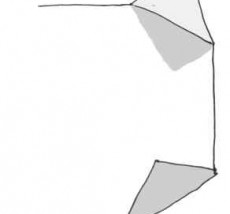Explore the properties of water, starting here with adhesion. What can you glue together with water?
 |
 |
An experiment about Liquids: Properties of water – adhesion
What you will need:
• squares of greaseproof or wax paper
• water
What you will do:
1. Take a square of greaseproof paper and fold 2 corners so they stick out – you will use them as handles.
2. Take another square and put about 5 drops of water in the middle of it.
3. Now place the first square of greaseproof paper on top of the drops of water. Make sure the handles point up.
4. Hold only the corner handles and carefully lift them. Does the water glue the two squares together so you can pick them both off the table?
5. Continue to add squares of greaseproof and lift them until the handles are no longer able to pick them all up.
What should happen:
What you are seeing is called ADHESION. Water molecules are boomerang shaped and one side of the molecule has a positive charge and the other has a negative charge. This means that water molecules are attracted to other molecules which have either a positive or negative charge, as well as to themselves. The water holds up the greaseproof paper in much the same way as a magnet holds up a nail.
Monster Challenges:
• Experiment with other materials. You could try plain paper, aluminium foil, even paper clips. What is water capable of holding up?
• What is a meniscus? What role does adhesion play in creating one? Do some research and find out.
Teaching Notes: Monster Sciences Experiment: Liquids LQ15
Key Concepts:
• Properties of water: Adhesion
Resources:
• Experiment description Liquids LQ15 – one copy per student.
• Squares of greaseproof or wax paper – about 10 per student, water
Lesson Notes:
As a class read through the proceedure of this experiment and discuss how the students are going to conduct the experiment. Explain your expectations regarding safety and the sensible use of water in the classroom.
At the end of this experiment you might like to consider a demonstration which will require an inflated balloon, something to build static electricity like a woollen jumper or pullover or your hair, and some running water. To demonstrate the electrical attraction of water, simply charge the balloon by rubbing it on the wool or your hair and then hold it beside, but not in, the gentle stream of water running from the tap. You should clearly see the water bend toward the balloon.
What should happen in this experiment and why?
Students should be able to glue together quite a few sheets of greaseproof with only water. They should be able to explain how the adhesive property of water achieves this.
Follow up question:
• What role does adhesion play in surface tension?
• Now that you know what adhesion is, have a guess as to what cohesion might be.



